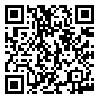BibTeX | RIS | EndNote | Medlars | ProCite | Reference Manager | RefWorks
Send citation to:
URL: http://ijhe.tums.ac.ir/article-1-165-en.html
Backgrounds and Objectives: in recent years, mobile bed biological reactors have been used progressively for municipal and industrial wastewaters treatment. Dissented experiment is a trial that significant changes will accrue for influent variables in the process, and generally used for identification of the effective factors and optimization of the process. The scope of this study was determination of the optimized conditions for the MBBR process by using of Taguchi method.
Materials and Methods: Reactor start up was done by using of the recycled activated sludge from Ahwaz wastewater treatment plant. After that and passing the acclimation period, with hydraulic residence time equal to 9 hours matched for 1000, 2000 and 3000 mg/l based on COD respectively, for optimization determination of the acclimated microbial growth, the variables change (pH, nitrogen source, chemical oxygen demand and salinity) were determined in 9 steps, and all of the results were analyzed by Qualitek -4 (w32b).
Results:In this study, organic load removal based on COD was 97% and best optimized condition for MBBR were (inf. COD=1000 mg/l, pH= 8, salinity = 5% and the Nitrogen source= NH4CL)
Conclusion: Based on our finding, we may conclude that Taguchi method is on of the appropriate procedure in determination the optimized condition for increasing removal efficiency of MBBR.
Received: 2009/03/4 | Accepted: 2009/05/5 | Published: 2013/07/6
| Rights and Permissions | |
 |
This work is licensed under a Creative Commons Attribution-NonCommercial 4.0 International License. |





